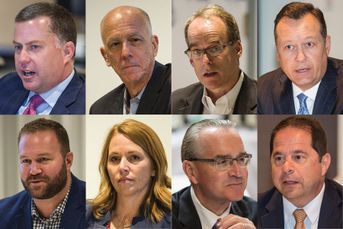Compensation is the largest expense that a firm incurs in most industries.
As the typical independent financial advisory firm continues to evolve, developing the next generation of partners and advisers is an imperative in an increasingly relationships-based wealth management industry. Compensating appropriately and staffing for the future is more important than ever: The 2017 InvestmentNews Adviser Compensation & Staffing Study now shows that the typical professional at independent financial advisory firms is no longer an “independent” adviser, but an employee of the firm – and potentially a future partner.
Read on to test your knowledge of the latest trends in how firms are compensating and recruiting their advisers.
1. What percentage of annual revenue does the typical advisory firm spend on compensation?
47%
52%
60%
68%
73%
79%
85%
91%
In 2016, the typical industry firm had $2.904 million in total expenses, of which $2.147 million (73%) was compensation related. The profitability of an advisory firm is defined by its productivity. Since nearly three-quarters of all expenses of the firm are compensation related, the higher the return on that compensation, the higher the profitability of the firm.
2. What does the typical independent advisory firm professional earn in total annual income, including salary, commissions, incentive bonus, and profit distributions?
Less than $75,000
$75,000-$100,000
$100,000-$125,000
$125,000-$150,000
$150,000-$175,000
$175,000-$200,000
$200,000-$225,000
$225,000-$250,000
More than $250,000
Spanning from Service Advisers who have 10 years of experience and earn a median of about $100,000 to individuals with more than 30 years in the industry who earn nearly $500,000, it pays to follow a career as an advisory firm professional, and the business stacks up well against many other traditional professional careers as the typical professional earns between $175,000-$200,000.
3. Over the last two years, how do you believe the annual salary for a lead adviser who is an employee of the firm has changed?
Decreased by 0-5%
Stayed the same
Increased by 0-5%
Increased by 5-10%
Increased by 10-20%
Increased by 20-25%
Increased by more than 25%
The 2015 median salary for lead advisers was $110,000, growing to reach $135,000 in 2017. This year’s study saw Lead Advisers’ salaries increase by 23% since 2015, the fastest rate seen for at least the past 10 years. In all likelihood, this was fueled by a jump in the demand for professional talent in the independent advisory space, which has doubled in size in terms of the number of advisers over the last decade when the industry as a whole has contracted.
4. When an advisory firm hires a new lead adviser, where was the most likely place he or she last worked?
RIA
IBD
Regional brokerage
Wirehouse
Asset manager or distributor
Insurance
brokerage
Other industry affiliation
Other industry
Recruited professionals come from all parts of the industry, not just the current affiliation channel of the hiring firm. About 9% of firms brought on at least one lead adviser in 2016 and were most commonly previously affiliated with an RIA, followed by wirehouses and regional brokerages. About 31% of lead advisers hired in 2016 were hired from a registered investment adviser, compared to 20% from wirehouses.
5. How long, on average, does it take a firm to bring on a new lead adviser hired as an employee, not partner, of the firm?
Less than three months
3 months
4 months
5 months
6 months
7 months
8 months
9 months
10 months
11 months
One year
More than one year
When firms search for a new hire, it takes them a long time to find a suitable candidate. Firms
report an average search time of six months to hire for the lead adviser position. This is double the time it takes for firms to find support (level 3) advisers. While lead advisers are in very high demand, they are difficult to recruit. Firms should begin forecasting staffing needs almost six months before the need for the new hire.
6. Over the last two years, how do you believe the annual salary for a lead adviser who is an owner of the firm (or a “practicing partner”) has changed?
Decreased by 0-5%
Stayed the same
Increased by 0-5%
Increased by 5-10%
Increased by 10-20%
Increased by 20-25%
Increased by more than 25%
About 73% of firms compensate their “practicing partners” (partners who are lead advisers) with salaries. In 2017 salaries of practicing partners are between $150,000 (1st quartile) and $250,000 (3rd quartile), with a median salary of $193,000, which is a 7% increase from two years ago.
7. How much, on average, does the typical independent advisory firm partner earn in total annual income (salary, incentive bonus, and distributions)? (NOTE: this calculation is an average, not median, and assumes all firm profits are distributed as partner income.)
Less than $300,000
$300,000-$350,000
$350,000-$400,000
$400,000-$450,000
$450,000-$500,000
$500,000-$550,000
$550,000-$600,000
$600,000-$650,000
$650,000-$700,000
More than $700,000
Partner income comprises compensation for working in the firm and profit from being an owner in the firm. Steady profits continue to increase partner income at advisory firms. Partners had an average
income of $558,000 in 2016. While partner income remains high, this is the first time in five years that the InvestmentNews research report found a decrease over the previous year.
Learn more about reprints and licensing for this article.








